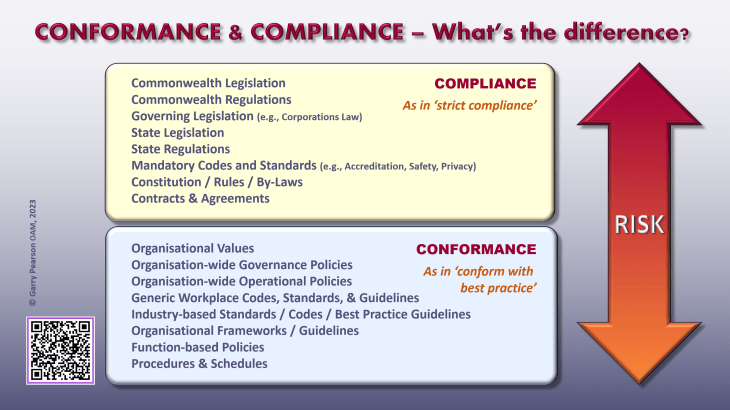We sometimes refer to aspirational goals as ones we might hope to achieve, while suspecting that they are beyond our reach. Yet, without aspiring to achieve great things, no great things can actually happen. So it is with nonprofit governance aspirations.
Aspiring to be compliant doesn’t offer much inspiration to your stakeholders, or your team. Aspiring to conform to a set of policies and standards may also be unlikely to spark enthusiasm. Despite this, directors and senior managers understand that these basic requirements are foundational to the achievement of higher aspirations. They are, therefore, necessary but not sufficient to achieve exceptional outcomes.
A spectrum of governance aspirations
The spectrum of governance aspirations illustrated below offers one way of seeing the hierarchy of compliance, conformance, and performance in the work of your board.

Aspirations are characterised by a steadfast desire for higher or better positions or outcomes. That’s another way of describing a commitment to continuous improvement.
Inspiration, apart from sharing linguistic roots with aspiration, is often used to refer to animating, exciting, or enthusing people to lift their performance – breathing life and meaning into their work.
Conformance and compliance – obligations or opportunities?
Two aspects of board effectiveness evaluations at high risk of being treated as box-ticking exercises are conformance and compliance. Both areas may be seen as a brake on strategic initiatives, perhaps binding you up in red- or green-tape measures.
For some, the terms conformance and compliance may be interchangeable, however, it is helpful to distinguish between them in the context of a Board evaluation. Compliance relates to strict adherence to legal and statutory obligations. Conformance, on the other hand, relates to a strong, but non-binding, commitment to meet certain best practice standards or frameworks, and to follow nominated guidelines. Each of these two main groups sub-divides into a hierarchy of obligations and commitments, as suggested in the chart below.

Legal obligations include those relating to directorial duties. One of those is the duty of care of course, and part of that care involves ensuring that the organisation is compliant with its legal and regulatory obligations.
When your board ensures compliance, this helps the organisation to avoid legal and ethical risks, and fosters a stable and responsible environment. Compliance guarantees that the nonprofit operates within the boundaries set by regulators and maintains transparency and accountability to stakeholders.
When the board focuses on conformance, on the other hand, this helps drive quality improvement. By aligning with quality standards and best practices, your organisation can enhance its programs, services, and operations. Conformance is foundational for continuous learning and adaptation to better meet the needs of beneficiaries and fulfill the nonprofit’s mission.
Both compliance and conformance complement each other in providing quality assurance and supporting quality improvement. Compliance underpins lawful conduct, while conformance empowers the organisation to excel and innovate within the parameters set by compliance. Together, these elements contribute to your nonprofit’s effectiveness, impact, and sustainability.
Evaluating the awareness and understanding of your compliance and conformance commitments also informs future training and professional development for directors, staff, and volunteers.
Your compliance register
Compiling a compliance register is one of the steps you can take to map all of your obligations, risk rate them, assign responsibility for adherence, describe how obligations are addressed, and regularly review the applicable legislation and regulations.
The template format illustrated below offers one approach to designing such a register, which can be adapted to your needs.

Beware ‘trojan horse’ obligations
While advising a client recently, I noticed that while they had documented a range of compliance and conformance obligations, some of the frameworks and standards listed in their register contained additional legal and regulatory obligations. Embedded obligations like these could easily be blind spots in your organisation’s compliance register, with no monitoring or reporting being done to permit the board to govern effectively in the affected areas.

It is therefore prudent for your Governance Committee to review any contracts, and accreditation, registration, or standards documents, to see whether they might contain further hidden obligations. Once these have been uncovered, they can be elevated to their rightful place in the register, alongside other compliance and conformance obligations.
They may also offer opportunities for improving quality outcomes and optimising organisational performance … worthy aspirational goals.
See also:

